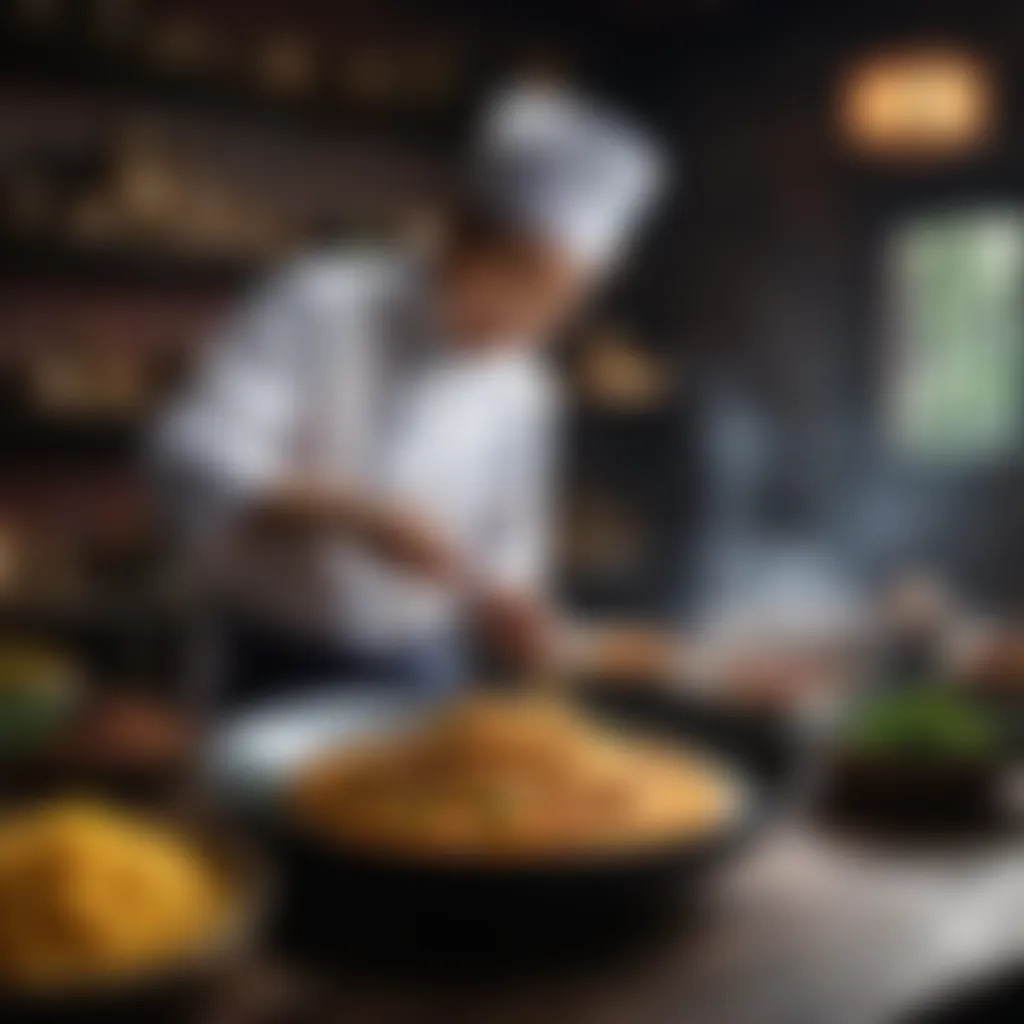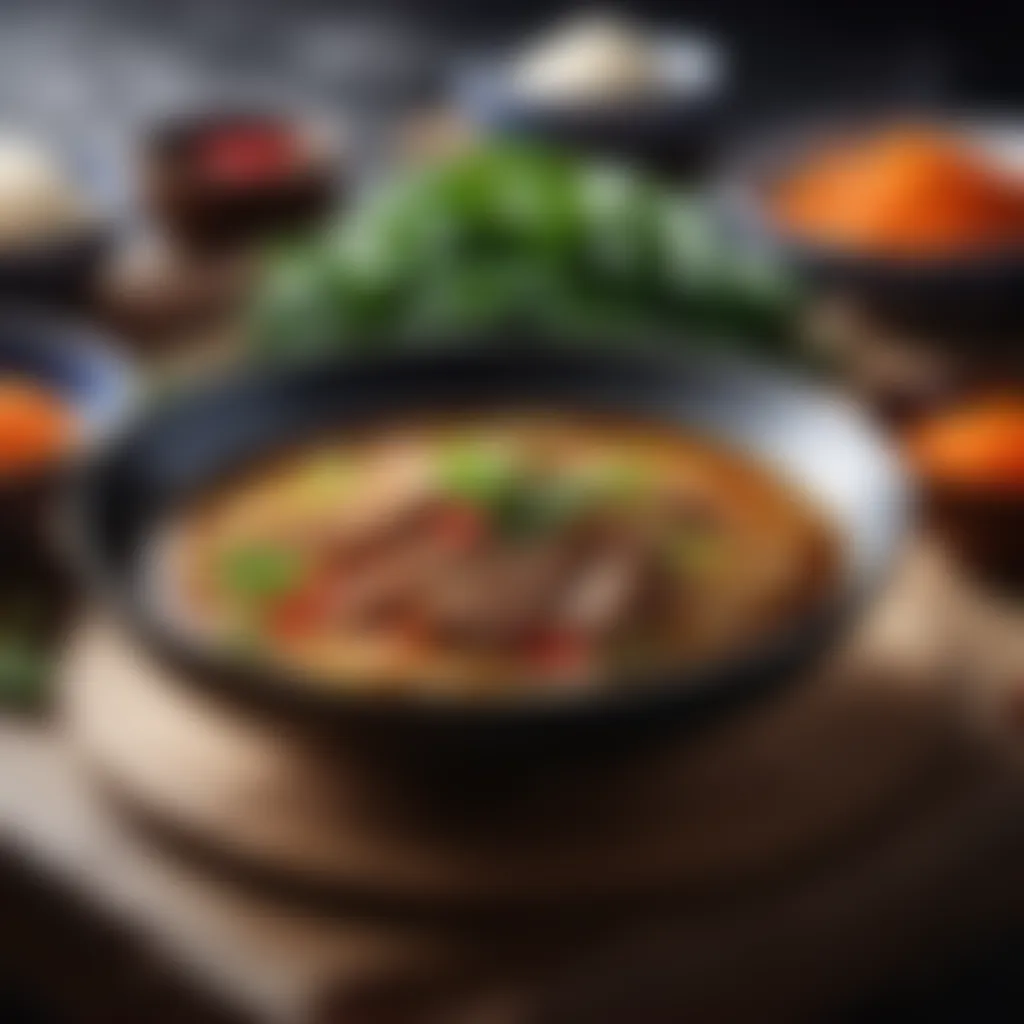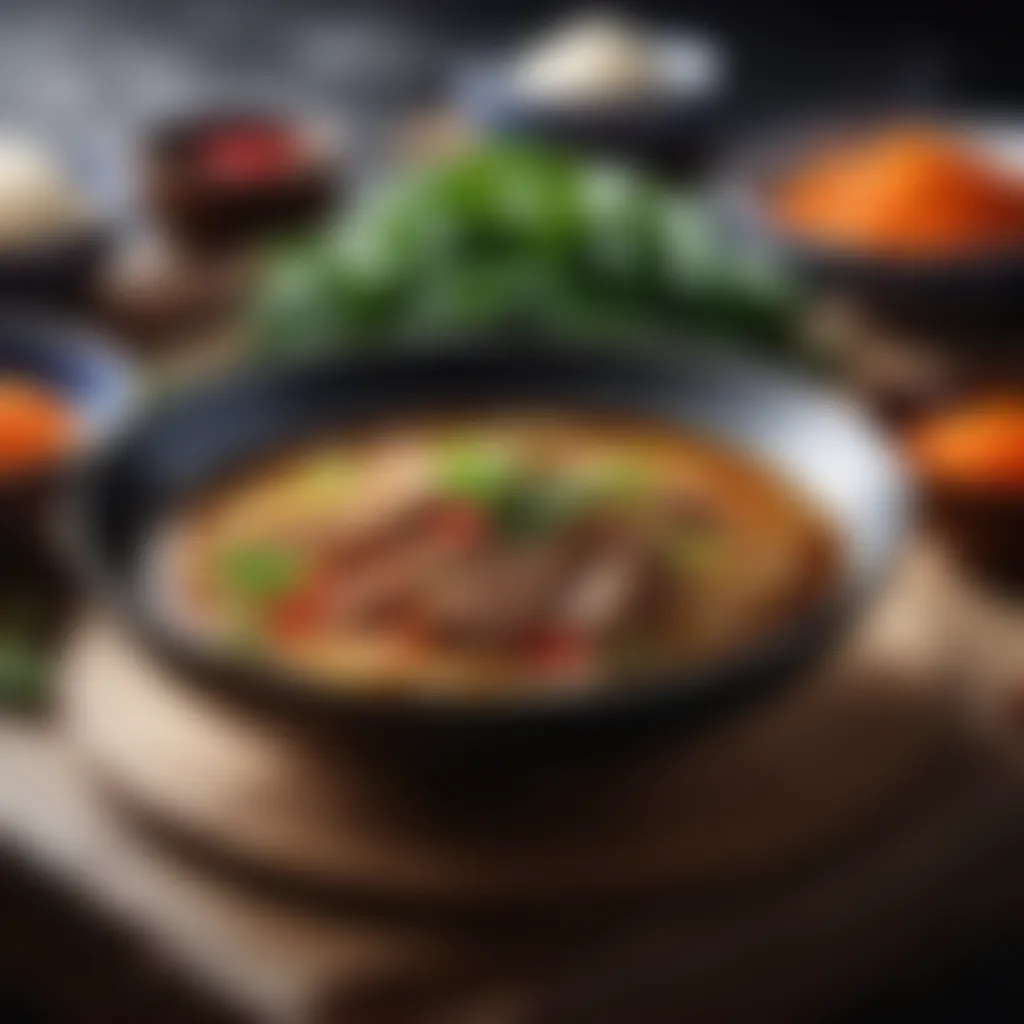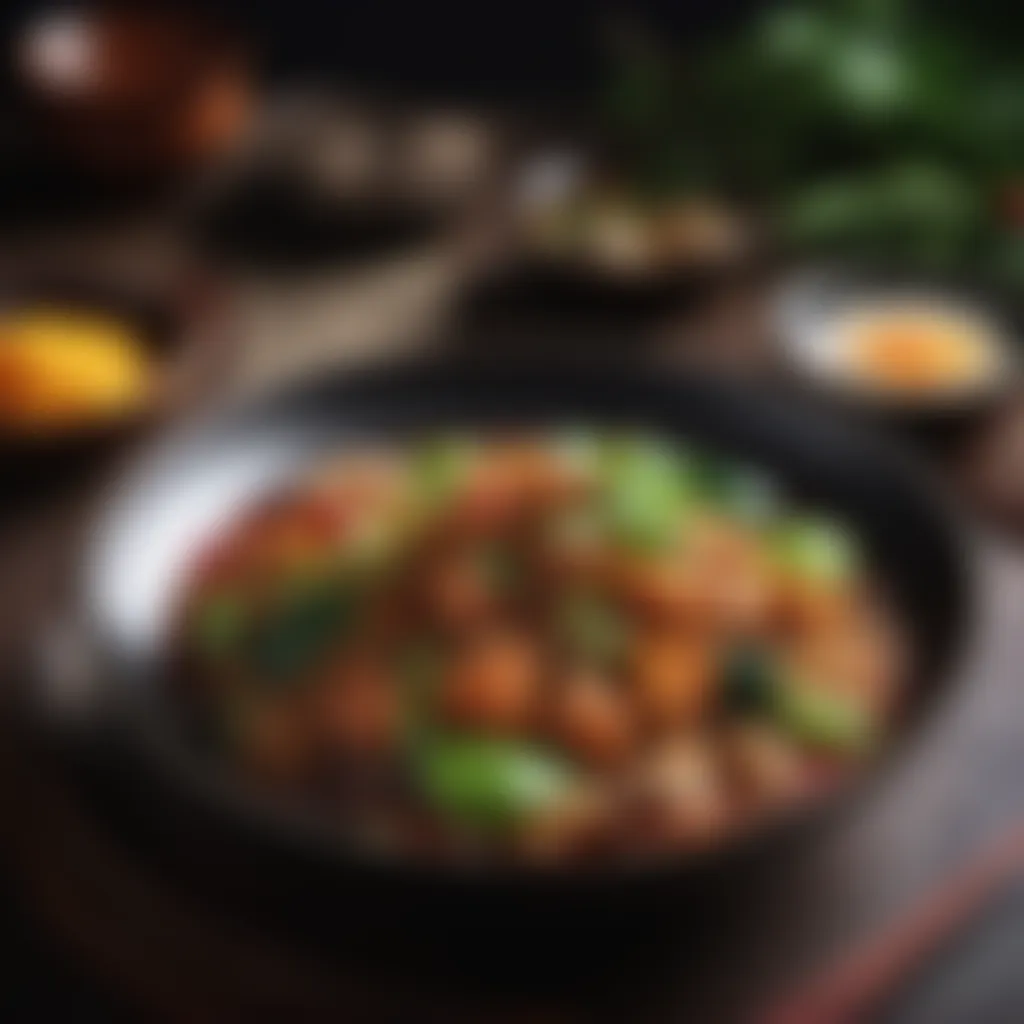Discovering Anhui Cuisine: A Journey Through Flavors


Intro
Anhui cuisine, also known as Hui cuisine, offers a unique glimpse into a world where flavors tell stories and ingredients speak of the land. Nestled in the heart of China, this culinary tradition exhibits a rich history that has evolved alongside the region's cultural tapestry. From the vivid landscapes of the Huangshan Mountains to the meandering rivers that carve through the province, Anhui's geography significantly influences its gastronomy. The use of various cooking techniques, signature ingredients, and carefully crafted recipes culminates in a culinary experience that is both hearty and complex.
In this article, we embark on a journey through Anhui cuisine—providing you the essential knowledge, tips, and tricks needed to recreate its traditional flavors in your own kitchen. Whether you are a seasoned cook or a curious beginner, this guide is tailored to empower every housewife to dive into the rich and diverse world of Anhui cooking with confidence. Let’s start this culinary adventure by gathering our ingredients and preparing to create something truly memorable.
Ingredients:
To whip up some classic dishes that represent Anhui's rich culinary heritage, gather the following ingredients:
- 300g of fresh river fish (such as grass carp)
- 200g of bamboo shoots, thinly sliced
- 150g of mushrooms, preferably shimeji or shiitake
- 2 tablespoons of vegetable oil
- 2 tablespoons of soy sauce
- 1 tablespoon of Shaoxing rice wine
- 1 teaspoon of salt
- 1 tablespoon of sugar
- 2 cloves of garlic, minced
- 1 thumb-sized piece of ginger, peeled and sliced
- 2 green onions, chopped
- 1 cup of chicken or vegetable broth
These ingredients will help lay the foundation for a delightful Anhui dish that embodies both depth and flavor.
Preparation Steps:
Follow these detailed instructions to ensure everything is prepped and ready for cooking:
- Rinse the fish thoroughly under cold water and pat dry with a paper towel.
- Prepare the bamboo shoots by peeling and slicing them into thin pieces, ensuring they are uniform for even cooking.
- Clean the mushrooms with a damp cloth and slice if necessary.
- Mince the garlic and peel and slice the ginger into thin strips.
- Chop the green onions and set aside for garnishing at the end.
Having everything chopped, sliced, and ready will streamline the cooking process.
Technical Aspects:
Understanding the technical aspects of cooking Anhui dishes is crucial. Keep the following in mind when cooking:
- Heat Settings: Utilize medium to high heat for stir-frying ingredients quickly, allowing for that signature sear.
- Timing: Fish generally cooks fast (about 6-8 minutes), while bamboo shoots should be pre-cooked for 2-3 minutes if they're canned, otherwise fresh ones may need a little longer.
- Techniques: Stir-frying and braising are the two primary techniques employed in Anhui cuisine. Stir-frying ensures a crisp texture, while braising imbues the dish with rich, complex flavors.
Cooking Process:
Let’s get into the heart of cooking Anhui dish. Follow these sequential steps with care:
- Heat the vegetable oil in a large skillet over medium-high heat.
- Add the garlic and ginger to the oil and stir-fry for about 30 seconds until fragrant.
- Carefully place the fish into the skillet and cook for about 3-5 minutes on each side, or until golden brown. Remove the fish and set it aside.
- In the same skillet, add the bamboo shoots and mushrooms, stir-frying for another 2-3 minutes.
- Return the fish to the skillet, pouring in the soy sauce, Shaoxing rice wine, and broth. Let everything simmer together for about 5-7 minutes.
- Add the salt and sugar, adjusting to taste.
- Garnish with green onions just before serving.
Troubleshooting Tips:
While crafting Anhui dishes, it’s common to encounter some hiccups. Here’s how to address them:
- If the fish breaks apart: Ensure it's properly dried before pan-frying. A non-stick pan can also help.
- If the dish feels too salty: Add a sprinkle of sugar to balance the flavors.
- If cooking time exceeds the recommendations: Fish overcooked becomes dry; always keep an eye on it!
Following these tips will streamline your cooking process and enhance the final flavor of your Anhui dish. Enjoy the delightful experience of crafting authentic flavors that capture the essence of Anhui cuisine.
Foreword to Anhui Cuisine
In this section, we gather the threads that weave together a rich tapestry of Anhui cuisine. It's not just about the food on your plate; it’s a cultural narrative that runs deep, revealing the region's history and identity. Anhui cuisine has a unique flavor profile that reflects its soil, climate, and culture, distinguishing it from its more well-known counterparts like Sichuan or Cantonese cuisines. Understanding this culinary landscape provides invaluable insights into the traditional practices and innovations that characterize these dishes.
This exploration into Anhui cuisine uncovers several key elements. First, by delving into its historical context, we see how centuries of evolution have shaped what we recognize today. Second, examining the cultural influences allows us to appreciate the broader spectrum of customs and practices that contribute to the preparation and consumption of these dishes.
Moreover, recognizing this balance is vital for home cooks aiming to experiment with authentic Anhui flavors, while also appreciating their historical significance. This approach not only enhances culinary skills but also fosters a deeper connection with the food itself.
Historical Context
Anhui cuisine, often called Huizhou cuisine, boasts a long and intricate history, deeply intertwined with the region's geographical attributes and cultural transitions. Historically, this area was known for its rich agricultural environment, which has supplied the staples that define its dishes. The farmers here, particularly in the Huizhou region, relied on local ingredients that enhanced their health and vitality. While many Chinese cuisines developed around imperial courts or coastal trade cities, Anhui cuisine is rooted in local agricultural practices and community-centric cooking.
During the Ming and Qing Dynasties, the influence of merchants and the elite helped shape Anhui culinary practices, blending various techniques and preferences into its offerings. These interactions with other cultures not only enhanced the flavors but also introduced new ingredients, such as mushrooms and wild herbs. The variety of textures and tastes is not mere happenstance but reflects centuries of innovation and necessity.
Cultural Influences
To truly appreciate Anhui cuisine, one must recognize the significant cultural influences that mold its character. The philosophies of Confucianism, Buddhism, and Taoism all leave a mark on how food is prepared and enjoyed in Anhui kitchens.
For instance, the Confucian ideals of harmony manifest in the balance of flavors and presentation of dishes. Buddhism emphasizes the use of simple, wholesome ingredients, evident in many vegetarian options found in Anhui. Likewise, Taoism informs the cooking methods that prioritize natural processes, such as stewing and pickling, allowing for the ingredients’ intrinsic qualities to shine.
These cultural threads are further complicated by local customs, such as communal dining experiences, where meals are shared amongst family and friends, underscoring the importance of unity and cooperation.
In short, Anhui cuisine is not just a collection of recipes; it’s a reflection of the region’s rich history and diverse cultural influences that continue to inspire and shape the culinary landscape today.
Geographical Features and their Impact
In any culinary exploration, understanding the geographical nuances becomes paramount, especially when it comes to Anhui cuisine. This region, nestled in the heart of China, boasts an intriguing tapestry of natural elements that deeply influence its cooking methods and ingredient variety. From rolling hills to fertile valleys, Anhui’s diverse landscapes are a key player in shaping what ends up on the dinner table.
"Where you find your food can be just as crucial as how you prepare it. Learning about the roots—literally—gives a more rounded appreciation for every meal."


Topographical Diversity
The topography of Anhui is nothing short of stunning. Here, you have the majestic Huang Shan (Yellow Mountain), renowned for its unique granite peaks and countless pine trees. This mountainous region attracts a lot of rainfall, which allows for a bounty of crops to flourish. Also, the lower-lying areas are blessed with river systems that facilitate agriculture along with a varied ecosystem that nurtures local wildlife.
This natural diversity presents several advantages to Anhui’s cuisine. For example, mountain herbs that thrive in the cooler, misty air are frequently used in local dishes, contributing to their distinct flavors and health properties. The rivers yield fresh fish and crustaceans, which find their way into stews and braised dishes, cementing Anhui’s reputation as a place where flavor meets freshness.
Additionally, the interchange between high and low agricultural practices—roots and shoots—enables chefs to blend different types of ingredients, enhancing the culinary experience. Using food from the hills and valleys provides a contrast of textures that enriches each dish.
Climate and Agriculture
The climate of Anhui plays a pivotal role as well. Characterized by a humid subtropical climate, the region enjoys four distinct seasons. This variability allows farmers to cultivate a diverse range of crops throughout the year. Think about it: in spring, fresh greens begin their reign, while summer brings an array of vibrant vegetables. Autumn is the time for harvesting grains and legumes, making it a bustling period for local farmers. Finally, winter sets the stage for root vegetables, which are perfect for stews.
Moreover, the blend of humidity and sunshine creates ideal conditions for rice cultivation, a staple in many Anhui dishes. The local preference often sways towards rice noodles and breads, which serve as perfect companions to sumptuous stews or rich sauces.
It’s also interesting to note that many Anhui cooks incorporate seasonal ingredients into their dishes rather than relying on preserved versions. This practice might be rooted in a deep respect for what the land offers—eating what is fresh and in-season fosters a connection between diners and the land.
In sum, the geographical features of Anhui—its topographical diversity and favorable climate—not only foster agricultural bounty but also elevate the region's culinary profile. When we enjoy Anhui cuisine, we're not just tasting food; we're experiencing the land itself.
Core Ingredients in Anhui Cooking
When diving into the realm of Anhui cuisine, one quickly realizes that the core ingredients play a pivotal role in shaping its identity. These ingredients not only contribute to the flavors and textures of the dishes but also reflect the local environment and cultural heritage. Understanding these components is essential for anyone looking to recreate the essence of Anhui food in their own kitchen.
Herbs and Spices
In the world of Anhui cooking, herbs and spices are like the paint on an artist's palette. They add depth, color, and character to each dish. The use of herbs and spices in Anhui cuisine is a thoughtful process that highlights local flora while enhancing the natural flavors of the main ingredients.
One prominent herb in this culinary tradition is wild shell ginger, often used for its aromatic qualities. Similarly, dried tangerine peel is a staple, providing a subtle citrus note that elevates dishes.
Benefits of these herbs and spices include:
- Flavor enhancement: Herbs like ginger and garlic create a robust base, allowing the intricate flavors of cooked proteins and vegetables to shine.
- Health advantages: Many herbs have medicinal properties, such as anti-inflammatory benefits and digestive aids, which resonate well with today’s health-conscious cooks.
- Cultural significance: The use of these ingredients often ties back to historical practices, gathering places for local communities where knowledge of herbs was passed down through generations.
Local Vegetables and Proteins
No discussion of Anhui cuisine can be complete without mentioning its local vegetables and proteins. The region's agricultural landscape is diverse, offering a wide variety of fresh produce that forms the backbone of many traditional dishes. Handpicked seasonal vegetables, such as lotus root and bamboo shoots, are commonly seen gracing the dining table.
Among the locally sourced proteins, river fish holds a celebrated status—fresh water ensures the fish retains its delicate flavor. Tofu, made from local soybeans, is extensively used as well, prized for both its versatility and nutritional value.
Key points around local vegetables and proteins include:
- Sustainability: Utilizing fresh, local products reduces the carbon footprint and supports local farmers, maintaining the region’s agricultural integrity.
- Flavor profile: Each ingredient interacts uniquely to create complex taste experiences, characteristic of Anhui dishes. For instance, the crunch of bamboo shoots complements the soft texture of braised tofu beautifully.
- Seasonal eating: Anhui cuisine encourages a connection with the seasons, inspiring cooks to adjust their recipes according to what’s available, promoting freshness and variety.
"Understanding the core ingredients in Anhui cooking is like unlocking a treasure chest of flavors and health benefits. They tell a story from the land to the table."
Distinct Cooking Techniques
In the world of Anhui cuisine, cooking techniques are the backbone that holds the intricate flavors and textures together. The way food is prepared directly affects not only the taste but also the nutritional value and overall presentation on the plate. Anhui’s cooking methods are deeply rooted in its history and geography, adding layers of complexity and depth to the dishes. By mastering these techniques, home cooks can bring a splash of Anhui's culinary richness into their kitchens.
Stewing and Braising
Stewing and braising stand out as two foundational techniques in Anhui cooking. These methods emphasize slow cooking, allowing the ingredients to meld together for hours, creating rich and robust flavors.
The Importance of Stewing and Braising:
- Flavor Development: Stewing often involves larger cuts of meat and a variety of vegetables. When cooked slowly, the meat tenderizes and absorbs flavor from the broth, resulting in a dish that is both hearty and savory. Consider the likes of stewed pork belly, where the fat renders beautifully into the sauce, enriching every bite.
- Nutritional Benefits: Slow cooking helps retain vitamins that might be lost in quicker methods. This is particularly advantageous when using root vegetables or leafy greens.
- Versatility: While stewing is often associated with meats, it can also be applied to legumes and grains, making the possibilities endless.
Considerations:
- Time is key; stewing and braising require patience. But the reward is a comforting meal that carries the essence of tradition.
Popular Dishes:
- Beef stew with daikon radish
- Braised chicken with chestnuts
- Herbal lamb stew
Smoking and Pickling Methods
Smoking and pickling have a unique place in the heart of Anhui cuisine, elevating both flavors and preservation techniques. These methods are less common in everyday cooking, yet they offer a wealth of impactful aromas and textures.
The Role of Smoking and Pickling:
- Unique Flavors: Smoking infuses food with a smoky richness. It’s often used for meats and fish, where a few hours of exposure can transform a simple protein into something extraordinary. Smoked duck, for instance, becomes a showcase dish, revered for its depth and complexity.
- Preservation: Pickling is not just about taste; it’s a practical solution for extending the shelf-life of seasonal vegetables. Vinegar, salt, and spices work together to create tangy sensations that can brighten up any meal. Pickled mustard greens often accompany braised dishes, adding a contrasting crunch and dimension to the palate.
Considerations:


- Experimenting with different wood types for smoking can yield various flavor profiles, from sweet to savory.
- Homemade pickling allows for customization, so families can craft flavors that reflect their heritage or personal preferences.
Popular Examples:
- Smoked fish with aromatic herbs
- Pickled cabbage and carrots
"Cooking is one of the greatest gifts you can give to yourself. The techniques you use determine not just taste but soul of the dish."
By embracing these distinct cooking techniques, you can bring Anhui's rich culinary traditions into your home, enhancing not only the flavors but also cultivating a deeper appreciation for this remarkable cuisine. As you explore and implement these methods, you’ll uncover a world where every meal tells a story, inviting you to engage with its rich heritage.
Signature Dishes of Anhui Cuisine
When exploring Anhui cuisine, the**** signature dishes stand as a proud testament to its culinary identity. Each dish tells a story rich in culture and tradition, deeply embedded in the region's historical context. They are not just meals but rather symbols of community and artistry. Anhui cuisine is often referred to as ‘an artist's palette,’ with each signature dish playing its unique part in the collective tapestry of flavors that define this remarkable gastronomy. This section will delve into three standout dishes that encapsulate the essence of Anhui’s culinary legacy and underline their significance.
Sautéed Bamboo Shoots
Sautéed bamboo shoots are a crisp and refreshing dish, often relished during the spring months when bamboo shoots are harvested. The preparation is relatively straightforward but requires the right technique to bring out the natural flavors. Freshly sliced bamboo shoots, slightly sautéed with garlic and a drizzle of vegetable oil, offer a delicate crunch that pairs wonderfully with simple seasonings, emphasizing the purity of the produce.
This dish holds an important place in the hearts of Anhui locals as it encapsulates the region's respect for natural flavors and seasonal ingredients. The slight bitterness of the shoots balances beautifully with the sweet notes of other dishes on the table, showcasing the culinary principle of contrast, a hallmark of Anhui gastronomy. It's not just a dish; it is also a symbol of springtime renewal.
Stewed Tofu with Mushrooms
Tofu is a staple in many Chinese cuisines, but Anhui's version shines with the addition of earthy mushrooms. The stewing process allows the tofu to absorb the rich umami flavors of the mushrooms, creating a comforting dish that resonates with home-cooked warmth.
Typically, this dish involves soft tofu gently simmered with mushrooms like shiitake or oyster, bathed in a savory sauce made from soy sauce, ginger, and a splash of shaoxing wine. The beauty lies in the simplicity; each ingredient plays a crucial role without overpowering the others. This dish not only reflects the culinary techniques of Anhui but also speaks to the philosophy of using what the land provides.
This dish encourages folks to explore the balance between different textures and tastes and serves as an excellent meat alternative, appealing to health-conscious diners.
Braised Fish in Soy Sauce
Braised fish in soy sauce is another signature dish that brings people together around the dinner table. The preparation is meticulous; choosing the right fish, such as carp or catfish, is vital for achieving the desired richness in flavor. The fish is usually marinated in soy sauce along with ginger, scallions, and a hint of sugar before being braised slowly until it reaches a tender, melt-in-your-mouth consistency.
"This dish is often seen as a way to celebrate family gatherings, as fish symbolises abundance and good fortune in Chinese tradition."
The end result is a beautifully presented dish that looks as good as it tastes, with visual appeal marked by the glossy brown sauce draping over the firm, juicy flesh of the fish.
This dish showcases the art of braising, central to Anhui cuisine, allowing multiple flavors to meld over time, an approach that emphasizes patience and tradition in cooking.
Every signature dish in Anhui cuisine not just prioritizes flavor but also conveys the values of community and sustainability that are paramount to its culinary landscape.
The Role of Tea in Anhui Culinary Culture
Tea holds a special place in the heart of Anhui cuisine, serving more than just a beverage. For many, it embodies warmth, hospitality, and a way of life. The rich flavors, diverse varieties, and cultural significance of tea play an integral role in dining experiences across the region. Every layer of this culinary culture reveals the importance of tea, as it harmonizes with local dishes and connects diners to history and tradition.
Tea Varieties and Pairings
Anhui is celebrated for its tea, notably the Keemun black tea, renowned worldwide for its rich aroma and flavor. Then there’s Huangshan Maofeng, a blossoming green tea which brings a delicate, refreshing quality. Each type of tea possesses unique properties, guiding potential pairings with various Anhui dishes.
- Sautéed Bamboo Shoots: The mild flavors of this dish easily match with Keemun black tea that enhances the sweetness of the bamboo while cutting through the umami.
- Stewed Tofu with Mushrooms: A lighter green tea like Huangshan Maofeng complements the earthiness of the mushrooms while adding a refreshing note.
- Braised Fish in Soy Sauce: A robust black tea serves as a counterpoint, holding its own against the strong, salty flavors of the dish.
Pairing tea correctly not only enhances the flavors but also elevates the entire culinary experience, tying together the intricate notes found in Anhui's cuisine.
Tea Workshops and Ceremonies
Participating in tea workshops and ceremonies offers a deeper understanding of tea's role in Anhui's culture. These events expose individuals to the artistry behind tea making. From choosing the right leaves to mastering the steeping process, each step reflects a craft honed over generations.
During these classes, enthusiasts often engage in traditional tea ceremonies, which emphasize the respect and mindfulness associated with consuming tea. It is not just about drinking but also appreciating the whole process—from the sound of boiling water to the sight of leaves unfurling in hot water.
"The harmony in a tea ceremony mirrors the ideal balance sought in Anhui cuisine, where each ingredient and flavor finds its rightful place."
In this modern era, many young chefs and housewives alike are rekindling the art of tea. Workshops are popping up in urban centers, encouraging a new generation to embrace traditional practices. Often paired with local cuisine, these workshops create a unique synergy between tea and food, making every meal an occasion worth cherishing.
Through these experiences, tea evolves from a mere drink to a pivotal element in Anhui's culinary narrative, showcasing the importance of tradition in contemporary settings.
Modern Adaptations of Anhui Recipes
Adapting traditional recipes from Anhui cuisine is more than just a culinary exercise; it’s a bridge that connects the old ways to modern palates. As we inch further into a rapidly changing world that prioritizes convenience and health, modern adaptations of Anhui recipes become significant. These adaptations reflect contemporary tastes while preserving the essence of dishes that have stood the test of time.
One of the main elements driving the evolution of Anhui cuisine is the infusion of techniques and flavors from different culinary cultures. Today, home cooks and professional chefs alike are experimenting with global ingredients to add a refreshing twist to Anhui dishes, making them appealing not just to locals but to an international audience. For instance, you might encounter a stir-fried bamboo shoot dish that incorporates Mediterranean olives, creating a unique synergy of flavors that maintains the dish’s original character while appealing to a wider range of tastes. This cross-cultural fusion not only excites the palate but also invites conversation at the dinner table.
Fusion Cuisine Trends


Fusion cuisine takes center stage in the modern culinary landscape, and Anhui recipes are not left on the sidelines. Chefs are on a mission to break traditional boundaries—think Sautéed Bamboo Shoots with Avocado Salsa or Braised Fish in a Coconut Curry Sauce. These culinary concoctions showcase the versatility of Anhui’s core elements while bringing in diverse influences.
The benefits of embracing these trends are far-reaching:
- Wider Appeal: By merging flavors, Anhui cuisine attracts food lovers who may not have considered trying traditional dishes.
- Creativity in the Kitchen: Home cooks can experiment, leading to new creations that reflect personal styles and tastes.
- Cultural Exchange: Fusion food promotes understanding across different culinary traditions, opening up avenues for appreciation and respect toward various cultures.
While fusion cuisine can be thrilling, it’s essential to remain respectful of the original recipes’ integrity. When reinterpreting, it is wise to keep the foundational flavors and techniques intact, ensuring the dish remains anchored to its roots.
Health and Wellness Considerations
As the world becomes more health-conscious, Anhui recipes are also seeing modern adaptations that focus on wellness. Today’s cooks are often looking for ways to make traditional dishes lighter and healthier without sacrificing flavor. One example is substituting high-sodium soy sauce with a low-sodium alternative or exploring the use of fresh herbs over heavy sauces.
Moreover, the incorporation of whole grains, such as brown rice in place of white rice, reflects a growing trend towards wholesome eating.
Important considerations in healthy adaptations include:
- Nutritional Value: Aim to include a variety of vegetables to boost fiber and vitamins, such as replacing deep-fried tofu with steamed or grilled options.
- Portion Control: While Anhui dishes are enticing, it’s helpful to practice moderation, particularly when serving rich, hearty meals. Use smaller plates or balance heavier dishes with lighter sides, like a fresh cucumber salad.
- Natural Ingredients: Advocating for organic products and fresh, local produce not only elevates the dish but also contributes to a sustainable cooking philosophy.
Dining Experiences in Anhui
Dining experiences in Anhui are a blend of tradition and modernity, where each meal is not just about sustenance but a celebration of culture and community. Anhui cuisine, known for its rich flavors and distinctive cooking methods, becomes a medium through which one can engage with the historical and cultural essence of the region. Engaging in these culinary experiences enriches the appreciation of Anhui's gastronomic heritage.
Both locals and travelers benefit from understanding the subtleties of dining etiquette and the evolving restaurant scene. Appropriately navigating these aspects represents respect towards the culinary arts and its practitioners, offering insights into how food connects people across generations. Moreover, the ambiance, service styles, and menu designs at contemporary establishments reveal how Anhui's cuisine adapts while keeping its roots intact, allowing diners to enjoy familiar tastes in refreshing formats.
Traditional Dining Etiquette
In Anhui, the art of dining is steeped in customs that reflect respect and consideration for one another. Understanding traditional dining etiquette can add layers of meaning to the meal. Here are some key points:
- Seating Arrangements: Typically, the most respected guest is seated furthest from the entrance. It's common for youngers to wait for elders to start eating before digging in themselves.
- Serving Practices: It’s customary for the host to serve the guests food first. Guests are expected to take turns serving one another, showing appreciation for the food and the company.
- Chopstick Use: Placing chopsticks upright in a bowl of rice is a sign of mourning and should be avoided. Instead, resting them on the designated holder while not in use is considered polite.
- Toasting: Toasts are an essential part of the meal, often signaling camaraderie and celebration. Hold your glass lower than the host’s glass while toasting to show respect.
Understanding these elements of etiquette not only enhances the dining experience but also fosters a deeper connection to the cultural roots of Anhui cuisine.
Contemporary Restaurant Scene
The contemporary restaurant scene in Anhui is vibrant and evolving, blending traditional flavors with modern interpretations. Here are a few aspects that make dining out in Anhui remarkable:
- Fusion Cooking: Many chefs experiment by combining Anhui recipes with culinary inspirations from other regions. This creates exciting fusion dishes that highlight Anhui ingredients in new ways.
- Artistic Presentations: Visual appeal in food has garnered attention, and restaurants often emphasize plating techniques that showcase colors and textures, transforming meals into visual feasts.
- Interactive Dining: Some restaurants offer cooking classes as part of the dining experience. Patrons can engage with chefs, learn about techniques, and enjoy meals they've had a hand in preparing.
- Locally Sourced Ingredients: Many establishments focus on using fresh local produce, embodying the essence of Anhui's agricultural heritage. Diners can savor flavors that are seasonally inspired.
The Future of Anhui Cuisine
As we look ahead, the future of Anhui cuisine necessitates a blend of tradition and innovation. It stands as a testament to the rich tapestries of history, geography, and culture that have influenced its formation. As it adapts to modern lifestyles and eating habits, Anhui cuisine continues to evolve, forging new identities while paying homage to the past. This duality is not just about survival; it enriches the culinary landscape, creating an opportunity for a new generation of cooks and enthusiasts to connect with age-old traditions.
Preservation Efforts
Preserving Anhui cuisine is crucial to maintaining its identity amid the whirlwind of modernization. Communities and culinary advocates strive to safeguard traditional methods and recipes, recognizing that food is more than just sustenance—it’s a cultural heritage waiting to be passed down.
- Community Workshops: Local cooking classes are popping up, where chefs teach the classic dishes of Anhui, giving participants a hands-on experience. This grassroots effort builds a strong foundation of knowledge, ensuring that techniques are not lost.
- Documentation Initiatives: Projects to document family recipes and techniques are underway. These endeavors often involve interviews with elder chefs, capturing the nuances that can make each dish unique. It’s a way of keeping stories alive alongside the food itself.
- Cultural Festivals: Events that celebrate Anhui cuisine not only elevate local dishes but also invite younger generations to engage with their culinary roots. Delicious food tends to draw people in—allowing them to explore and appreciate its history at their own pace.
Global Recognition and Trends
As Anhui cuisine finds its way onto international plates, it brings along its distinctive flavors and cooking styles. Global recognition offers both opportunities and challenges.
- International Collaborations: Chefs in places like Melbourne and New York are incorporating Anhui dishes into their menus, showcasing them alongside modern interpretations. This allows Anhui cuisine to engage with a wider audience while also ushering in new flavors.
- Social Media Influence: Platforms like Instagram and Facebook are powerful for food promotion. Visual storytelling can entice food lovers to learn about Anhui cuisine, leading to greater curiosity and appreciation. As users share their culinary experiences, they help create a global conversation around Anhui fare.
- Culinary Tourism: With more travelers seeking authentic culinary experiences, Anhui province has opportunities to attract tourists interested in not only tasting but also learning. Packages that offer cooking classes or guided food tours can enrich their visit while fostering a sustainable economy centered around cuisine.
"Food is not just about taste; it’s about identity, stories, and connections among people."
The exciting future of Anhui cuisine lies in the balance of preserving its essence while engaging with the world. This journey, enriched by both local traditions and global influences, provides a fertile ground for a culinary revival that respects history while embracing change.
By focusing on both preservation and innovation, Anhui cuisine can thrive, ensuring that its rich flavors and cooking techniques continue to shine brightly in the culinary spotlight.
Culmination
The conclusion of our culinary exploration is not just a mere wrapping up of information, rather it serves as a crucial moment to reflect on the journey we undertook through Anhui cuisine. This region's gastronomic identity is woven with rich history, culture, and innovation, offering insights that go beyond just taste.
Summarizing the Culinary Journey
Throughout this article, we have traversed a landscape of flavors and traditions, beginning with the historical context that laid the groundwork for Anhui's culinary distinctiveness. We explored how the interplay of geographical elements and climatic conditions fostered a unique agricultural scene, ripe with varied ingredients.
From the depth of flavors found in stewed dishes to the aromatic spices that elevate meals, each aspect contributes to Anhui’s rich tapestry. Signature dishes like sautéed bamboo shoots or braised fish highlight the meticulous techniques honed over generations. We also delved into the surrounding tradition of tea, further enriching the experience of Anhui dining, illuminating how every sip and bite forms a narrative of cultural significance.
"Culinary arts are not merely about nourishment; they encapsulate history and culture in each bite."
Final Thoughts on Anhui Cuisine
As we draw this journey to a close, it's essential to appreciate not only the flavors but the philosophy behind Anhui cuisine. It represents a thrilling blend of tradition and innovation, striving to maintain its roots while engaging with contemporary trends. The future of Anhui cuisine appears bright, nurturing both preservation efforts and a keen eye on global recognition.
For housewives and readers alike, the lessons gleaned from Anhui cuisine extend to understanding the art of cooking as a powerful form of expression that brings people together. Whether replicating traditional recipes or adapting them for modern wellness, Anhui cuisine affords a sense of community—a bond that is built upon sharing meals rich in stories, flavors, and memories.
Thus, the journey continues for anyone willing to engage with it, inviting you to experience the essence of this remarkable culinary heritage. The next meal can potentially be an adventure, touching on both the past and the present, and steering towards a future where traditions breathe through every dish prepared.







